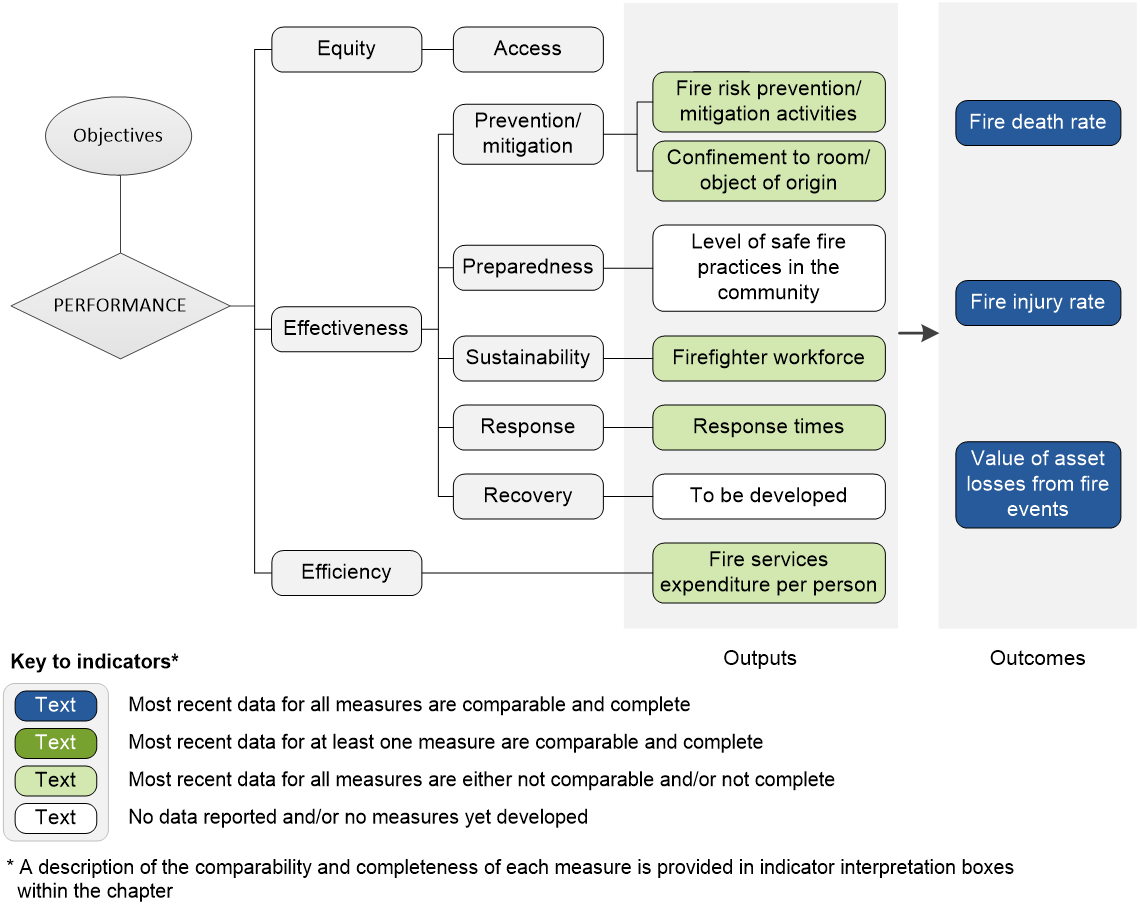Report on Government Services 2017
Volume D, Chapter 9
Emergency services for fire events
Performance reporting for fire events includes information on fire service organisations, which are one of the primary agencies involved in providing emergency management services for fire events. From the 2017 Report, Ambulance services is now reported in Volume E Health.
Download the chapter
- Chapter 9 Emergency services for fire events and attachment tables (PDF - 2594 Kb)
- Chapter 9 Attachment tables (XLSX - 886 Kb)
- Key Facts
- Indicator Framework
- Indicator Results
Nationally in 2015-16:
- fire service organisations attended a total of 382 440 emergency incidents, of which 97 433 were fire event incidents
- total expenditure of fire service organisations was $4.0 billion, or $168 per person in the population
- 18 980 full time equivalent (FTE) paid personnel were employed by fire service organisations, of which 76.3 per cent were paid firefighters. A large number of volunteer firefighters (226 509 people) also participated in the delivery of fire services.
Emergency services for fire and other events aim to build resilient communities that work together to understand and manage the risks that they confront, and to reduce the adverse effects of events on the community (including people, property, infrastructure, economy and environment). Governments’ involvement is aimed at providing emergency services that:
- contribute to the communities management of risks and its preparedness, through the promotion of risk reduction and mitigation activities
- are accessible, responsive and sustainable.
Governments aim for emergency services to meet these objectives in an equitable and efficient manner.
The performance indicator framework provides information on equity, efficiency and effectiveness, and distinguishes the outputs and outcomes of emergency services for fire events. The performance indicator framework shows which data are complete and comparable in the 2017 Report.

An overview of the Emergency services for fire events performance indicator results are presented. Information to assist the interpretation of these data can be found in the indicator interpretation boxes in the Emergency services for fire events chapter and attachment tables.
Effectiveness — prevention/mitigation indicators
Fire risk prevention/mitigation activities
Accidental residential structure fires per 100 000 households, 2015-16
| NSW | Vic | Qld | WA | SA | Tas | ACT | NT | Aust | |
|---|---|---|---|---|---|---|---|---|---|
| No. | 79.0 | 111.4 | 62.1 | 58.4 | 76.7 | 102.0 | 87.4 | 73.6 | 81.9 |
Estimated percentage of households with a smoke alarm/detector, 2015-16
| NSW | Vic | Qld | WA | SA | Tas | ACT | NT | Aust | |
|---|---|---|---|---|---|---|---|---|---|
| % | 93.6 | 97.2 | 96.5 | 91.0 | na | na | na | 80.0 | na |
Confinement to room/object of origin
Proportion of building fires confined to room of origin, all ignition types, 2015-16
| NSW | Vic | Qld | WA | SA | Tas | ACT | NT | Aust | |
|---|---|---|---|---|---|---|---|---|---|
| % | 73.3 | 71.7 | 68.2 | 69.4 | 66.3 | 57.0 | 78.0 | 90.4 | na |
Effectiveness — sustainability
Firefighter workforce
Proportion of FTE employees who exited the firefighting workforce, 2015-16
| NSW | Vic | Qld | WA | SA | Tas | ACT | NT | Aust | |
|---|---|---|---|---|---|---|---|---|---|
| % | 1.4 | 0.1 | 3.6 | 1.8 | 6.8 | 2.1 | 2.8 | 6.1 | 1.8 |
Effectiveness — response
Response times to structure fires
State-wide response times to structure fires — including call taking time, 90th percentile, 2015-16
| NSW | Vic | Qld | WA | SA | Tas | ACT | NT | Aust | |
|---|---|---|---|---|---|---|---|---|---|
| min. | 14.4 | 10.6 | 12.2 | 15.7 | 12.9 | 17.2 | 10.2 | 15.8 | .. |
State-wide response times to structure fires — excluding call taking time, 90th percentile, 2015-16
| NSW | Vic | Qld | WA | SA | Tas | ACT | NT | Aust | |
|---|---|---|---|---|---|---|---|---|---|
| min. | 12.2 | 9.8 | 11.6 | 14.2 | 14.0 | 16.3 | 9.0 | 13.6 | .. |
Efficiency indicators
Fire service organisations’ expenditure per person
Fire service organisations' expenditure per person, 2015-16
| NSW | Vic | Qld | WA | SA | Tas | ACT | NT | Aust | |
|---|---|---|---|---|---|---|---|---|---|
| $ | 135.27 | 243.25 | 128.12 | 151.22 | 142.67 | 272.95 | 214.49 | 190.96 | 167.97 |
Outcome indicators
Fire death rate
Fire death rate, per million people, 2015
| NSW | Vic | Qld | WA | SA | Tas | ACT | NT | Aust | |
|---|---|---|---|---|---|---|---|---|---|
| no. | 2.9 | 4.2 | 4.4 | 3.9 | 6.5 | 9.7 | 10.2 | 4.1 | 4.1 |
Fire injury rate
Rate of hospital admissions due to fire injury, per 100 000 people, 2014-15
| NSW | Vic | Qld | WA | SA | Tas | ACT | NT | Aust | |
|---|---|---|---|---|---|---|---|---|---|
| no. | 15.0 | 12.1 | 17.7 | 19.7 | 19.6 | 19.8 | 8.0 | 79.4 | 16.3 |
Value of asset losses from fire events
Value of fire event household insurance claims per person, 2015-16
| NSW | Vic | Qld | WA | SA | Tas | ACT | NT | Aust | |
|---|---|---|---|---|---|---|---|---|---|
| $ | 20.79 | 26.34 | 26.93 | 21.62 | 37.35 | 62.89 | 15.02 | 17.32 | 25.46 |
Notes
These data and caveats for these data are available in chapter 9 and attachment 9A.
na Not available. .. Not applicable.